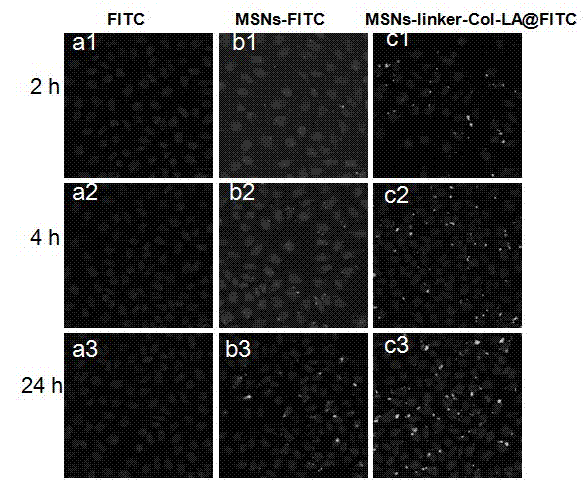Meso-porous silicon nano-drug carrier with both reduction responsiveness and targeting ability and preparation method thereof
A nano drug carrier, mesoporous silicon technology, applied in the field of medical materials, can solve the problems of low conversion rate, difficulty in balancing reduction responsiveness and targeting, unsatisfactory drug performance, etc., and achieve low cost and good cell compatibility High performance and versatility
- Summary
- Abstract
- Description
- Claims
- Application Information
AI Technical Summary
Problems solved by technology
Method used
Image
Examples
Embodiment 1
[0030] This embodiment mainly includes the following steps:
[0031] a. Monodisperse mesoporous silicon nanoparticles prepared by sol-gel and template method;
[0032] b. Using 3-aminopropylsilane coupling agent to modify the mesoporous silicon nanoparticles obtained in step a to prepare aminated mesoporous silicon nanoparticles;
[0033] c. Using succinic anhydride to react with the aminated mesoporous silicon nanoparticles obtained in step b to prepare carboxylated mesoporous silicon nanoparticles;
[0034] d. Using cystamine molecules (rich in disulfide bonds) to functionalize the carboxylated mesoporous silicon nanoparticles obtained in step c to prepare disulfide bond-modified mesoporous silicon nanoparticles;
[0035] e. Using the disulfide bond-functionalized mesoporous silicon nanoparticles obtained in step d of collagen molecule blocking to prepare a mesoporous silicon / collagen molecule reduction-responsive nanocomposite system;
[0036] f. Using the mesoporou...
Embodiment 2
[0050] This example prepares the preparation of mesoporous silicon / collagen-lactobionic acid multifunctional nanocomposite particles with both reduction responsiveness and targeting.
[0051] Including the following steps: a. Synthesis of mesoporous silicon nanoparticles: First, 1 g of cetyltrimethylammonium bromide and 0.28 g of sodium hydroxide were uniformly dispersed in 480 mL of distilled water, vigorously stirred and heated to 80 °C. Add 5 g tetraethyl orthosilicate dropwise to the above solution with a uniform injector, and stir vigorously for 2 h until the mixture becomes a white suspension. Then, the prepared mesoporous silicon nanomaterials with surfactants (CTABMSNs) were uniformly dispersed in 150 mL of methanol / hydrochloric acid (135 mL: 15 mL) mixture. After vigorous stirring, the above solution was refluxed in a water bath at 80°C for 48 hours to effectively extract the surfactant (CTAB) and obtain mesoporous silica nanoparticles (MSNs) with regular pore struct...
Embodiment 3
[0059] This example, as the first experimental example of the present invention, studies the reduction-responsive behavior of mesoporous silicon / collagen-lactobionic acid multifunctional nanocomposite particles.
[0060] In this study, FITC was used as a model drug to investigate the reduction-responsive release characteristics of the mesoporous silica / collagen-lactobionic acid composite system.
[0061] First, the present invention investigates the effect of threothiobiitol (DTT) on the release behavior of the nanocomposite system. The specific experimental process is as follows: two groups of 3.3 mg FITC-labeled mesoporous silica / collagen-lactobionic acid particles and 3.3 mg collagen-adsorbed mesoporous silica nanoparticles were dissolved in 3 mL of PBS, and loaded with 30 mg and 0 mg respectively. and 30 mg of DTT to make three mixed solutions. Then, all the above mixed liquid was transferred to a dialysis bag (molecular weight greater than 14,000), placed in a container ...
PUM
| Property | Measurement | Unit |
|---|---|---|
| Specific surface area | aaaaa | aaaaa |
| Specific surface area | aaaaa | aaaaa |
Abstract
Description
Claims
Application Information
 Login to View More
Login to View More - R&D
- Intellectual Property
- Life Sciences
- Materials
- Tech Scout
- Unparalleled Data Quality
- Higher Quality Content
- 60% Fewer Hallucinations
Browse by: Latest US Patents, China's latest patents, Technical Efficacy Thesaurus, Application Domain, Technology Topic, Popular Technical Reports.
© 2025 PatSnap. All rights reserved.Legal|Privacy policy|Modern Slavery Act Transparency Statement|Sitemap|About US| Contact US: help@patsnap.com



